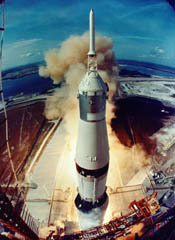It was on this day that astronauts Neil Armstrong and Edwin (“Buzz”) Aldrin, Jr. bounced among lunar craters and Armstrong uttered the oft-quoted line, “One small step for man, one giant leap for mankind.” But did you know that the total lunar rock samples from the Apollo missions weighed nearly 900 lbs.? Or that the Apollo spacecraft itself weighed 44 tons and stood nearly 60 ft. high? The famous Apollo 11 landing was only one mission in several decades of space exploration. During this tremendous period, the USSR and the United States led the way in the exploration of the great unknown of space. The “space race,” as it was called, between the USSR and the United States, embodied the Cold War. One country launched the first rocket; the other the first artificial satellite. The USSR claimed the first walk in space, while the U.S. claimed the first walk on the moon. In 1957, the first artificial satellite, Sputnik I, was launched by the USSR - thus initiating the “space race.” Soon after, the United States launched Explorer I, the first American satellite. Altogether, nearly 50 unmanned probes from both countries explored the lunar-earth system. The competition between the countries soon expanded to other planets, including neighboring planets, Venus and Mars. On April 12, 1961, the USSR took a bold lead in the race when the cosmonaut Yuri Gagarin, in Vostok 1, became the first person to orbit the earth. But the U.S., lagging behind the USSR, was soon to follow. Television sets around the world were tuned into the historic lunar landing of Apollo 11 on July 20, 1969. For those who witnessed the event, the team of three Apollo 11 astronauts—Neil Armstrong, “Buzz” Aldrin, and Michael Collins (who orbited the craft around the moon)—seemed to embody the ideals and hopes of all human beings. From this trip and subsequent Apollo missions, much was learned about the physical constitution and early history of the earth’s only natural satellite, including information about magnetic fields, heat flow, volcanism, and seismic activity. The total lunar rock sample returned to earth weighed nearly 900 lbs. (400 kg). Earlier advances in rocket technology allowed for the initial lift-off of the Apollo spacecraft. The three-stage Saturn V rocket, developed 7.5 million lbs. (3.4 million kg) of thrust at liftoff, giving the Apollo spacecraft a powerful boost. At launch, the total assembly stood 363 ft (110 m) high and weighed more than 3,000 tons. Following the success of the Apollo 11 missions, where were the space programs to go? Manned space stations became the next goal for the competing space programs. Skylab, an earth-orbiting space station that served as workshop and living quarters for three astronauts, was launched by the U.S. in May 1972.
